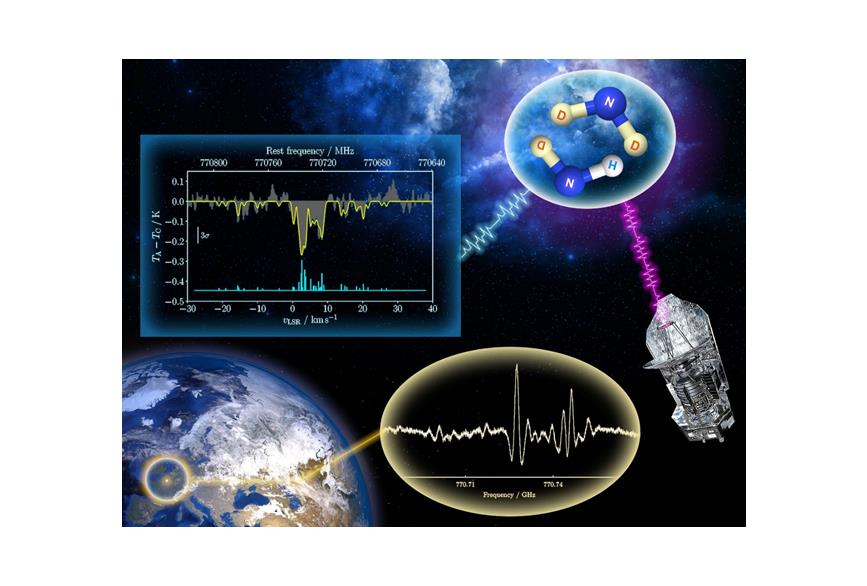About a decade ago, many astronomical observations were taken with the Herschel Space Observatory, an ESA/NASA mission. Some of the, were part of a project called “Chemical Herschel surveys of star forming regions” (CHESS) by Prof. Ceccarelli. These observations collected all the molecular signals, i.e. “spectra”, toward a source called IRAS 16293 (and a few others) over a wide range of frequencies. After analyzing them for the original science, the data went into the archive, where everyone can access and continue to use them.
Now, a decade later, researchers from University of Bologna, Max Planck for Extraterrestrial Physics, and AILES beamline measured new spectra of NHD and ND2 in the laboratory; they were able to look back at the old observations and identify these molecules in space for the first time!
The original observations weren't intended to detect NHD and ND2 -but it didn't matter- because the molecules were already there, just waiting for the laboratory work a decade later. Their results now give us a further, important insight into how deuterium (a heavier isotope of hydrogen) chemistry operates in the interstellar medium and influences molecular evolution in star- and planet-forming regions.
The chemistry of the interstellar medium is known mostly thanks to the observation of molecular emission in the form of photons, corresponding to the energy lost by molecules during its rotation in the gas-phase. These signals, or spectra, are collected by radio-telescopes operating at millimeter/submillimeter-wavelengths and allow the identification of the chemical composition of astronomical objects. However, molecules can be identified in space only if they had been previously studied (and interpreted) in the laboratory. For this reason, a team of scientists from three different country combined their facilities to study the spectrum of two radicals, NHD and ND2. These two species are isotopic forms of amidogen radical (NH2) which is an intermediate in the formation mechanism of interstellar ammonia (NH3). While the laboratory spectrum of NH2 has already been studied and the amidogen radical was known to exist in the interstellar medium, the information available for NHD and ND2 were rather scarce. The spectral recording started in Bologna and continued in Garching, but the narrow frequency coverage of the instruments did not allow a thorough interpretation of the observed features. Indeed, the spectra of such small molecules are spread across a wide range of frequencies. This issue could be overcome with the use of the bright far-infrared radiation extracted by the AILES beamline at SOLEIL. The powerful radiation source was used into a Fourier-transform interferometer to investigate the rotational spectrum of NHD and ND2 at higher frequency; the obtained data were then combined with those from the other laboratories into a joint-analysis. As a result of this work, the molecular fingerprints of NHD and ND2 could be identified for the first time in the low-mass protostar IRAS 16293 (see Figure), one of the astronomical objects observed by the Herschel telescope during its lifetime.

Graphical representation of the steps that led to identification of interstellar NHD and ND2: (i) first, the laboratory spectra of these species have been studied at SOLEIL and in two other institutions and then (ii) the Herschel archive data have been used to identify NHD and ND2 towards the low-mass protostar IRAS 16293.
It should also be pointed out that despite the low cosmic abundance of deuterium (around 0.0015 % of the hydrogen abundance), the observed abundances of NHD and ND2 are quite high, between 10 and 80 % of that of NH2. Indeed, deuterated molecules can be found in the interstellar medium in very large amounts: this is due to the so-called “deuterium fractionation processes”, i.e. the deuterium enrichment in a given molecules, which may occur efficiently under certain physical conditions, as for example a low gas temperature (5–20 K). These conditions are often found in very young stars (protostars), thus making them an ideal laboratory to study deuterated species. However, such a high enhancement can hardly be explained by astrochemical models and future observations of these species might provide more insights into the mechanism of ammonia formation and deuteration in the interstellar medium.
Mattia Melosso acknowledges Brett A. McGuire for his inspiring tweet and Ningjing Jiang for the wonderful figure.
